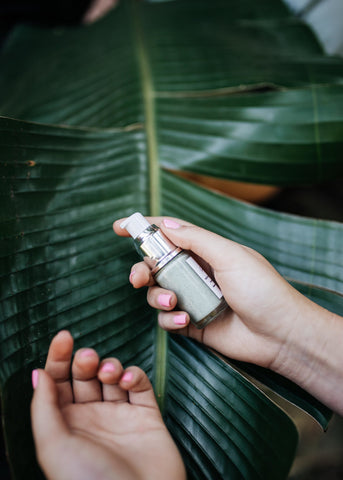The rosacea struggle is real! There are a lot of different symptoms you can experience with rosacea. It is a challenging skin concern to treat and one that can really knock your confidence.
The good news is, with some changes to your lifestyle and skincare routine, you can minimise the severity and frequency of rosacea flare ups.
Keep reading to learn more about the symptoms of rosacea and what you can do about them.
Contents
- What is Rosacea?
- What causes rosacea?
- Common Rosacea triggers
- Best skincare products for rosacea
- Skincare routine for rosacea
What is Rosacea?
Rosacea is a chronic skin condition associated with persistent redness and flushing. The severity of this chronic, inflammatory skin condition can range from occasional hot flushing to persistent redness, acne-like bumps, and broken capillaries.
Symptoms associated with rosacea:
- Blushing, facial redness, and flushing with hot, uncomfortable skin
- Visible blood vessels
- Bumps that look like acne (Rosacea is often confused with acne as symptoms are very similar)
- Thickening of the skin
- Dryness and scaling
- Prickly, itchy or burning sensations
Typically, rosacea shows up around the cheeks and nose but you may experience it around your chin and forehead too. It’s common for rosacea to appear later in life, after the age of 30, and research shows it affects more women than men.
Left untreated, rosacea can escalate from mild symptoms like occasional hot flushing to more permanent and serious skin issues such as broken capillaries, thickening skin, and permanent redness.

What causes rosacea?
Rosacea is a chronic skin condition and despite the research of health and skin professionals, it’s still a mystery as to why rosacea occurs initially. Currently, there is no cure.
It’s not all bad news though. While we may not know what causes rosacea, to begin with, there’s a lot we know about what triggers rosacea flares and increases severity.
Understanding these triggers can help you manage and minimise symptoms.
Rosacea triggers include:
- Spicy food and hot beverages
- Alcohol
- Unprotected or prolonged sun exposure
- Stress
- Vigorous exercise. Exercise can heat up your body and increase blood circulation; both trigger symptoms.
- Foods that contain cinnamaldehyde including tomatoes, citrus, cinnamon, and chocolate
- Hot showers
- Certain skincare products
As you can see, many lifestyle factors can exacerbate symptoms but everyone will be triggered by the same things. Identify your personal triggers as early as possible and then take a holistic approach with appropriate lifestyle and skincare adjustments.
The best skincare products for rosacea
Rosacea skin has a weakened skin barrier making it highly sensitive and easily inflamed.
It’s crucial to be really selective about the skincare products you use. Many ingredients that won’t cause an issue on normal skin can be extremely irritating for rosacea-prone skin.
Below are a few ingredients to avoid and those to include in your skincare routine.
Ingredients to avoid if you have rosacea
❌ Glycolic Acid
❌ Benzoyl Peroxide
❌ Salicylic Acid
❌ Alcohol
❌ Witch Hazel
❌ Sodium lauryl sulfate
❌ Eucalyptus and Peppermint oil
❌ Fragrance - including essential oils
Rosacea-friendly ingredients
Look for ingredients that help strengthen the skin barrier, calm, and moisturise skin.
- Vitamin B3 Niacinamide: Helps to strengthen a weakened skin barrier.
- ✔️ Hyaluronic acid: Promotes hydration which supports the skin barrier.
- ✔️ Aloe vera: Moisture boosting and calming
- ✔️ Jojoba oil: Aids in reducing inflammation and redness
- ✔️ Green tea: Calms and reduces redness
Skincare routine for rosacea
A very gentle, very basic skincare routine can help keep rosacea skin as calm as possible. Overwhelming the skin with too many products and ingredients will only exacerbate the issue.
Depending on the severity of your symptoms, you might choose to scale right back to a core routine of a cleanser, moisturiser, and SPF to begin with.
You could consider adding an antioxidant or hydrating serum at a later stage, once symptoms have calmed down.
Gentle cleanser
Choose a fragrance-free cleanser formulated for sensitive skin that promotes a healthy pH balance and won’t strip the skin of its natural oils and moisture.
Lightweight, calming moisturiser or face oil
Choose a moisturiser with ingredients that help to strengthen the skin barrier, hydrate and calm redness. Non-comedogenic, lightweight moisturisers or face oils are best suited to rosacea-prone skin.
We recommend:
NEPHELIUM STRENGTHEN 2 Soothing Balancing Moisturiser
or
PLUM LOVE French Plum Beauty Seed Oil

Daily SPF
Applying broad-spectrum sunscreen daily is non-negotiable in your rosacea skincare routine. Sun exposure is a common trigger for rosacea flares so keep your skin protected at all times.
Serum
Just because you have rosacea, it doesn’t mean serums are off-limits. It’s about finding one well tolerated by your skin. Look for serums containing antioxidants (especially vitamins C and E), hydrating, and anti-inflammatory ingredients.
We recommend: Simply Detox Serum which is gentle on skin. You’ll notice on the ingredients list it does contain witch hazel, but don’t worry! The witch hazel used isn’t in alcohol form, instead, it’s extracted with glycerin as the carrier. This makes it safe for sensitive skin, including rosacea.
Rosacea responds well to a consistent routine so once you find products and a routine that works, stick with it. Product hopping will only make symptoms worse.
Remember, this is a guide only! We always recommend you consult with a dermatologist or health care professional for their recommendation on topical and oral treatments for rosacea.


